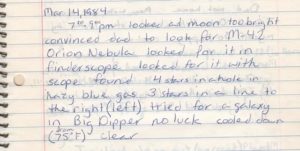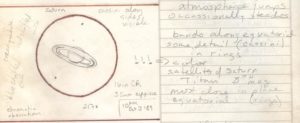Sky & Telescope's Observing Editor offers a few suggestions to help you set up your first (for fifth!) observing notebook.

Elizabeth Warner
Feeling inspired after reading Contributing Editor Bob King’s article on observing notebooks in the September 2017 issue of Sky & Telescope but need help starting a notebook? Here are a few different ways to approach the problem.
I use three types of observing notebooks. One is a simple spiral-bound book that goes everywhere I go. In it I record most of my “spur of the moment” observations: a sketch of a Venus-Jupiter conjunction I made at a minor league baseball game, sketches of constellations I’ve viewed through various plane windows, binocular sketches made while leaning back from a campfire, and so on. I have a second, more formal, log book I use during planned observing sessions — in my backyard, at star parties, or on a “big bino” camping trip. In addition to ruled lines, each page of that notebook has a blank field-of-view circle in which I draw the most important view of the night.
Third, I use several logbooks dedicated to observing programs designed by the Astronomical League (AL) . The AL requires specific data be recorded before “credit” is awarded for an observation, so pre-printed sheets are useful for organizing my data. Contributing Editor Matt Wedel has designed several logbooks for the AL observing programs, and I’ve made good use of at least four of them. After I’m done observing for the night, I re-draw relevant sketches from my field notebooks onto these sheets. So, there’s a certain amount of redundancy set up in my observing records, which is good in case of fire, but also good in that drawing and re-drawing helps me truly learn an object.

Elizabeth Warner
My notebooks often contain a lot of seemingly superfluous details — what the weather was like, who was observing with me, how cold I was, how I felt about finding — or not finding! — a particular object. My comments sometimes contain an embarrassing number of exclamation points. The point is: the observing log is about you and your view of the sky. Don't worry about grammar or spelling (well, you might want to learn how to properly spell the Pleiades). Don't worry about a lack of artistic talent, either. None of that matters here.
There are several observing logs, in both digital and paper format, available for purchase out there, and you might have to try a few before you find the one that works for you. Many amateur astronomy organizations also offer advice on or materials for keeping a logbook. If none of the pre-designed logbooks work for you, but you’re not quite sure how to lay out a notebook page, check out the American Association of Amateur Astronomers (AAAA), for instance. The AAAA offers free observing forms and sheets for field drawings.
Sketching, even badly, helps me study and memorize an object. If you enjoy sketching, you may find yourself investing in an entire artist’s workshop so you can draw in color, or you may decide a spiral notebook and a pencil works just fine. For more inspiration on this front, visit the following sites:
- Aquarellia (Michel Deconinck)
- Belt of Venus (Jeremy Perez)
- Deep-Sky Watch (Michael Vlasov)
- Cloudy Nights (amateur astronomy forum)
- Alexander’s Astronomy Sketching (Alexander Massey)
Clear skies and good observing!
 0
0
Comments
You must be logged in to post a comment.